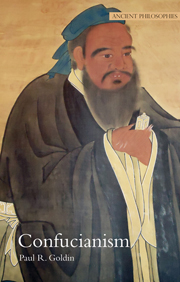Book contents
- Frontmatter
- Contents
- Chronology
- Introduction: what Confucianism is and what Confucianism is not
- 1 Confucius and his disciples
- 2 Interlude: Great Learning and Canon of Filial Piety
- 3 Mencius
- 4 Xunzi
- 5 Neo-Confucianism and Confucianism today
- Appendix: Manhood in the Analects
- Notes
- Guide to further reading
- Bibliography
- Index of passages
- Index
Introduction: what Confucianism is and what Confucianism is not
- Frontmatter
- Contents
- Chronology
- Introduction: what Confucianism is and what Confucianism is not
- 1 Confucius and his disciples
- 2 Interlude: Great Learning and Canon of Filial Piety
- 3 Mencius
- 4 Xunzi
- 5 Neo-Confucianism and Confucianism today
- Appendix: Manhood in the Analects
- Notes
- Guide to further reading
- Bibliography
- Index of passages
- Index
Summary
Confucianism is China's oldest and most revered philosophy. In imperial times, Confucius's standing was so great that the few writers who questioned his teachings became notorious for that reason alone. But in his own day, Confucius was taken as a wise but iconoclastic and potentially dangerous teacher of young men, and for many generations after his death, Confucians still struggled with exponents of other philosophies for primacy in the intellectual world of the so-called Warring States period (453–221 BCE). In keeping with the orientation of the Ancient Philosophies series, this book will focus on Confucianism as it was conceived and moulded by the earliest masters – in an age when Confucianism was regarded as but one of many viable philosophies, and did not yet enjoy the cultural supremacy that would come in later centuries. That later story will be reviewed briskly in the final chapter, along with a consideration of the standing of Confucianism today.
An exacting yet workable definition of Confucianism is crucial because the boundaries have been drawn both too broadly and too narrowly in the past. In this book, I shall use the term “Confucianism” to refer to the philosophy of Confucius (551–479 BCE), his disciples, and the numerous later thinkers who regarded themselves as followers of his tradition.
- Type
- Chapter
- Information
- Confucianism , pp. 1 - 6Publisher: Acumen PublishingPrint publication year: 2010



